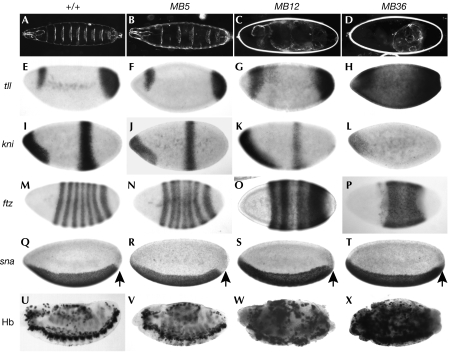Figure 3.
Phenotypic analysis of gro alleles. (A–D) Cuticles of wild-type (+) and gro mutant embryos. MB5 embryos show a weaker phenotype (loss of two or three even-numbered denticle belts) than MB12 or MB36. MB12 embryos are neurogenic but retain more body mass than MB36. Expression of (E–H) tll, (I–L) kni and (M–P) ftz transcripts in blastoderm embryos, showing that MB5 and MB12 retain activity. tll expression is wild type in MB5, slightly expanded in MB12 and throughout the embryo in MB36, indicating residual activity in MB12. Expression of the central stripe of kni is reduced in most MB12 embryos, but not completely abolished as in MB36. Stripes of ftz expression are irregular in MB5, broadened in MB12 and completely fused in MB36. (Q–T) Expression of sna transcripts is expanded towards the posterior pole in MB12 or MB36 embryos (indicated by arrows) in a manner resembling the sna expression pattern in hkb mutants (Goldstein et al, 1999), indicating that repression mediated by Hkb is lost in MB12 embryos. (U–X) Staining of stage 13 wild type and gro for the neural marker Hb. MB12 and MB36 mutants show ectopic expression of Hb protein that is characteristic of excessive neural development. ftz, fushi tarazu; Gro, Groucho; Hb, Hunchback; Hkb, Huckebein; kni, knirps; sna, snail; tll, tailless.

